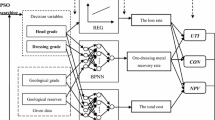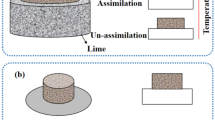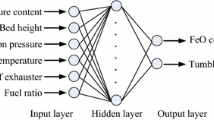Abstract
Optimization of sinter ore allocation is a key step in the steel production process, which has become the most important measure for steel enterprises to effectively reduce cost, improve quality, save energy and reduce emissions. In this paper, the first intelligent recommendation model for the sintering dosing scheme considering cost, quality and carbon emission in the sintering process is developed using the SA2PSO optimization algorithm combined with machine learning. To improve the optimization accuracy and speed of the PSO algorithm, the SA2PSO algorithm is based on the adaptive and simulated annealing operations to achieve different stages of particle optimization, and the convergence speed is reduced by about 5 s compared with PSO while ensuring the optimization accuracy. Based on the optimal solution, the random forest algorithm was used to achieve a high-accuracy prediction of quality. For carbon emission, this paper for the first time to our knowledge converts carbon tax into iron ore sintering cost, establishes a dosing scheme considering cost carbon emission and quality and finally establishes an intelligent recommendation model for sintering dosing based on VIKOR. The model can be used for optimal ore allocation in sintering to achieve low cost, high quality and low CO2 emission in iron ore sintering.





Similar content being viewed by others
References
Y. Wang, J. Zhang, Z. Liu, C. Du, J. Schenk, J. Shao, and Y. Zhang, J. Clean. Prod. 234, 157–170 https://doi.org/10.1016/j.jclepro.2019.06.186 (2019).
L. Ren, S. Zhou, T. Peng, and X. Ou, Renew. Sustain. Energy Rev. 143, 110846 https://doi.org/10.1016/j.rser.2021.110846 (2021).
Y. Wang, Z. Liu, J. Zhang, Y. Zhang, L. Niu, and Q. Cheng, J. Clean. Prod. 252, 119855 https://doi.org/10.1016/j.jclepro.2019.119855 (2020).
M. Hao, Q. Yu, C. Wei, Y. Chen, L. Chai, and Y. Ge, J. Mater. Eng. Perform. https://doi.org/10.1007/s11665-022-06765-w (2022).
K.J. Li, J.L. Zhang, Z.J. Liu, B.X. Su, L.T. Kong, and T.J. Yang, Int. J. Miner. Metall. Mater. 21, 216–224 https://doi.org/10.1007/s12613-014-0888-7 (2014).
C. Feng, H. Zhang, Y. Wang, and Z. Jiang, Shangdong Metall. 33, 24–269 https://doi.org/10.16727/j.cnki.issn1004-4620.2011.03.030 (2011).
Y. Li, M. Wu, W. Cao, C. Wang, and X. Lai, Control Theory Appl. 28(7), 1740–1746 (2011).
L. Sun and X. Wu, Frontier Computing: Theory, Technologies and Applications (FC 2019) (Springer, Singapore, 2020), pp. 98–104. https://doi.org/10.1007/978-981-15-3250-4_12.
X. Shen, L. Chen, S. Xia, X. Qin, and Z. Xie, Sci China Technol. Sci. 60, 1625–1637 https://doi.org/10.1007/s11431-017-9072-9 (2017).
Q. Feng, Q. Li, Y. Wang, and W. Quan, Control Theory Appl. 39, 923–932 https://doi.org/10.7641/CTA.2021.10221 (2022).
C.A.C. Coello, G.T. Pulido, and M.S. Lechuga, IEEE Trans. Evol. Comput. 8, 256–279 https://doi.org/10.1109/TEVC.2004.826067 (2004).
Y. Wang, Z. Cai, Y. Zhou, and W. Zeng, IEEE Trans. Evol. Comput. 12, 80–92 https://doi.org/10.1109/TEVC.2007.902851 (2008).
R. Nshimirimana, A. Abraham, and G. Nothnagel, Neural Comput. Appl. 33, 11355–11385 https://doi.org/10.1007/s00521-020-05555-6 (2021).
J. Kennedy, R. Eberhart, in Proceedings of ICNN'95-International Conference on Neural Networks (IEEE, 1995), pp. 1942–1948. https://doi.org/10.1109/ICNN.1995.488968
D. Gan, Technol. Innov. Appl. 12, 11–14 https://doi.org/10.19981/j.CN23-1581/G3.2022.05.003 (2022).
C.M. Yan, G.Y. Lu, Y.T. Liu, X.Y. Deng, in 2017 13th International Conference on Natural Computation, Fuzzy Systems and Knowledge Discovery (ICNC-FSKD) (IEEE, 2017), pp. 239–242. https://doi.org/10.1109/FSKD.2017.8393146
W.-N. Chen, J. Zhang, Y. Lin, N. Chen, Z.-H. Zhan, H.S.-H. Chung, Y. Li, and Y.-H. Shi, IEEE Trans. Evol. Comput. 17, 241–258 https://doi.org/10.1109/TEVC.2011.2173577 (2012).
Y. Bi, A. Lam, H. Quan, H. Liu, and C. Wang, Russ. Phys. J. 64, 866–875 https://doi.org/10.1007/s11182-021-02403-5 (2021).
Q. Yan, R. Ma, Y. Ma, and J. Wang, J. Xidan Univ. 48, 120–127 https://doi.org/10.19665/j.issn1001-2400.2021.04.016 (2021).
H.R. Tizhoosh, in International Conference on Computational Intelligence for Modelling, Control and Automation and International Conference on Intelligent Agents, Web Technologies and Internet Commerce (CIMCA-IAWTIC'06) (IEEE, 2005), pp. 695–701.
P.J. Van Laarhoven, and E.H. Aarts, Simulated Annealing: Theory and Applications (Springer, 1987), pp7–15. https://doi.org/10.1007/978-94-015-7744-1_2.
W. Yang, Z. Yan, and L. Sui, J. North China Inst. Sci. Technol. 12, 100–103 https://doi.org/10.3969/j.issn.1672-7169,2015.02.021 (2015).
Y. Shi, in Proceedings of the 2001 Congress on Evolutionary Computation (IEEE Cat. No. 01TH8546) (IEEE: 2001), pp. 81–86. https://doi.org/10.1109/CEC.2001.934374
Y.-W. Leung, and Y. Wang, IEEE Trans. Evol. Comput. 5, 41–53 https://doi.org/10.1109/4235.910464 (2001).
M. Bailera, P. Lisbona, B. Peña, and L.M. Romeo, J. CO2 Util. 46, 101456 https://doi.org/10.1016/j.jcou.2021.101456 (2021).
H. Zhang, W. Sun, W. Li, and G. Ma, Appl. Energy 309, 118485 https://doi.org/10.1016/j.apenergy.2021.118485 (2022).
L. Breiman, Mach. Learn. 45, 5–32 https://doi.org/10.1023/A:1010933404324 (2001).
Z. Maosheng, Vojnoteh. Glas. 70, 1–12 https://doi.org/10.5937/vojtehg70-35366 (2022).
Z.-P. Li, X.-H. Fan, G. Chen, G.-M. Yang, and Y. Sun, Neural Comput. Appl. 28, 2247–2253 https://doi.org/10.1007/s00521-016-2195-x (2017).
F.S. Opricovic and G.-H. Tzeng, Eur. J. Oper. Res. 156, 445–455 https://doi.org/10.1016/S0377-2217(03)00020-1 (2004).
Acknowledgements
The authors gratefully acknowledge the financial support provided by the National Natural Science Foundation of China (52174291), the Beijing New-star Plan of Science and Technology (Z211100002121115), the China Postdoctoral Science Foundation (2021M690369), the Central Universities Foundation of China (06500170), and the Guangdong Basic & Applied Basic Research Fund Joint Regional Funds-Youth Foundation Projects (2020A1515111008).
Author information
Authors and Affiliations
Corresponding author
Ethics declarations
Conflict of interest
The authors declare no conflict of interest.
Additional information
Publisher's Note
Springer Nature remains neutral with regard to jurisdictional claims in published maps and institutional affiliations.
Supplementary Information
Below is the link to the electronic supplementary material.
Rights and permissions
Springer Nature or its licensor (e.g. a society or other partner) holds exclusive rights to this article under a publishing agreement with the author(s) or other rightsholder(s); author self-archiving of the accepted manuscript version of this article is solely governed by the terms of such publishing agreement and applicable law.
About this article
Cite this article
Ma, Y., Zhang, J., Li, Q. et al. Intelligent Recommendation Framework for Iron Ore Matching Based on SA2PSO and Machine Learning to Reduce CO2 Emissions. JOM 76, 120–129 (2024). https://doi.org/10.1007/s11837-023-06211-9
Received:
Accepted:
Published:
Issue Date:
DOI: https://doi.org/10.1007/s11837-023-06211-9




